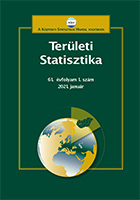Városhatáron belüli szuburbanizáció Magyarországon – egy paradoxon feltárása
Suburbanisation within the city in Hungary –
exploring a paradox
Author(s): Gábor László VasárusSubject(s): Social Sciences, Economy, Geography, Regional studies
Published by: Központi Statisztikai Hivatal
Keywords: suburbanisation; post-socialist urbanisation; intra-urban suburbs; urban sprawl; reurbanisation
Summary/Abstract: Suburbanization is one of the most defining processes of the post-socialist urban development. According to Czech, Slovak, and Polish examples, the process is differentiated at the sub-municipal level as much as at the municipal level. A typical case is when suburbanization occurs in villages previously attached to cities and their associated agricultural areas and scattered settlements. This study aims to prove the existence of the phenomenon in Hungary based on an empirical field survey and by analysing national statistical data. The outskirts and other inner areas of the agglomerations took on a significant population number in the surroundings of mid-size and large cities. In many cases, the population growth of the cities is entirely linked to such settlements, at the same time in many suburban villages only one of each settlement area has been affected by the influx. The basic trends and driving forces are similar to the foreign examples, furthermore, in Hungary, too, the process has been partly covered up in statistics by its certain features, so its significance in our country may be greater than previously assumed by the literature.
Journal: Területi Statisztika
- Issue Year: 62/2022
- Issue No: 04
- Page Range: 379-404
- Page Count: 26
- Language: Hungarian

